
Chapter 17 - Human Impacts: Marine Resources & Pollution |
17.1
Humans have been exploiting ocean resources for as long as our ancestors have been living on its shores back into antiquity. The oceans provide a major means of subsistence for about a quarter of the world's population. The exponential growth of the human population in the last 3 centuries have significantly impacted the physical environment, both land and water. This chapter starts with an examination of natural resources the oceans provide and also examines the degradation of the quality of the marine environment due to the addition of anthropogenic (from humans) materials.
The production and consumption of natural resources by the growing global human population is harming sea life throughout the world’s oceans. Laws and regulations are helping to manage some of the sources of ocean pollution. But, perhaps most detrimental, and the hardest to control, are the impacts of the behavior of people in their daily lives. This chapter examines the types and causes of ocean pollution, and the effects on sea life, and provides suggestions for some ways to mitigate problems. |
Click on thumbnail images for a larger view. |

Fig. 17-1. A healthy reef on Cordell Banks, California. |
17.2
Climate Change
The term "climate change" is often referred to in the news media related to a myriad topics. The simple definition, according to NASA is: "Climate change describes a change in the average conditions — such as temperature and rainfall — in a region over a long period of time." However, the impacts of changing climate conditions has a much broader scope relating to changes to the physical environment, biological ecosystems, and human-related conditions and activities. NOAA, NASA, USGS, and other science and environmental organizations have been intently studying climate change for decades. The topic at the forefront of discussion is global warming, and its impacts on global and regional scales, both on land and in the oceans. The
Earth’s surface is warming since the end of the last Ice Age, however, the global consumption of fossil-fuel energy sources, combined with land use and agricultural practices has resulted in the drastic increase carbon dioxide and other greenhouse gases in the atmosphere. As a result, many of the warmest years on record have happened in the past 20 years. Learn more about climate change and its impacts on NOAA's Climate Change website.
|
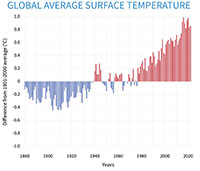
Fig. 17-2. Climate.gov graph showing the changing (rising) global average surface temperature for about the past 150 years. |
| Examples of impacts associated with climate change are shown below (there are many more!).
|
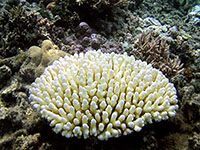
Fig. 17-2. Warming ocean temperatures impact sea life, such as coral bleaching. |

Fig. 17-3. Warming oceans result in more intense storm activity. |
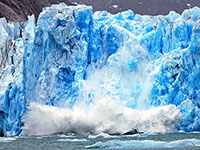
Fig. 17-4. Warming climate melts glaciers and sea ice, impacting ocean circulation. |
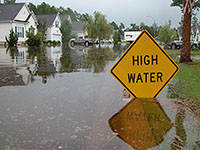
Fig. 17-5. Warming oceans lead to sea level rise and coastal flooding. |
|
17.3
Ocean Resources
A resource simply defined means something useful. Humans have been utilizing marine resources extending back into antiquity, but within the last couple centuries, exploitation of world marine resources have lead to increasing vulnerability to both resources of the natural environment and the communities who rely on them. Marine resources include exploitable physical resources (primarily petroleum, construction materials, and minerals) and biological resources (fish, shellfish, plants, and other wildlife utilized for fishing and aquaculture). A third category is aesthetic resources.
|

Fig. 17-6. Petroleum resources map of the world. Most resources occur in sedimentary deposits in modern and ancient continental margin regions. |
17.4
Petroleum (Oil & Gas) Resources in the Marine Environment
Without question, the petroleum and natural gas industry is the largest source of jobs and revenue in the world, involving seven out of top ten of the world's largest corporations and is the largest source of wealth for countries around the world. Oil and gas reserves in marine and coastal regions is the largest natural resource. Almost all oil and gas resources occur in sediment-filled basins along continental margins or in regions within continents that were ocean-margin basins in the geologic past (Figure 17-2).
The Middle East region has the greatest amount of oil & gas resources (Saudi Arabia, Iraq, Iran, and other countries around the Persian Gulf). Venezuela, Canada, Russia also have significant reserves. About 1/3 of world’s reserves occur on continental margins.
Sadly, petroleum consumption is at the heart of the environmental, economic, and social issues related to greenhouse gas/global warming, climate change, ocean acidification, and related issues.
What is the difference between a resource and a reserve?
The term resource applies to the total amount of material that occurs in a region. In the case of petroleum (oil and gas), this includes “fuel” that is both discovered and undiscovered, and may or may not be economically recoverable. In contrast, reserves are deposits of fossil fuels that are known to exist in a region with a reasonable level of certainty based on geologic and engineering research. A reserve is only a portion of a resource that is economically recoverable based on technologies that already exist. The value of an oil field is only based on the amount of petroleum that can be reasonably extracted over a period of time. The reserves of the world’s oil resources are constantly changing. For instance, the new technology associated with fracking has nearly doubled the amount of petroleum reserves in the United State in the last decade, whereas the resource assessments have remained essentially unchanged.
Unfortunately the easiest to access reserves on land and in shallow coastal areas have already been exploited and depleted, forcing ongoing exploration for future reserves into deeper water.
|
17.5
Sand & Gravel Resources
Sand and gravel accumulates along shorelines and on continental shelf regions where waves and currents winnow away finer clay fractions allowing coarser sediments to accumulate (Figure 17-7).
After petroleum, in economic terms, extraction of sand and gravel from the seabed is the next largest marine physical resource. Sand and gravel are increasingly being mined from continental shelf regions as sources on land in crowded coastal regions are being depleted or operations are restricted do to changes in land use. Sand and gravel are added to cement used in building foundations and is used in all forms of construction, including artificial island and levees (Figure 17-8).
Sand is mined from offshore areas and pumped in slurry form to replenish beaches that loose sand to beach erosion. Offshore sand and gravel mining operations are expensive, but the impact is as visually obvious as land-base operations, but benthic communities can be impacted by offshore dredging activities.
Offshore dredging is currently used to replenish beach sand in San Diego County. It is the source of sand for artificial beaches like Miami Beach, Florida and massive coastal construction projects in many places including Dubai, Saudi Arabia, and the construction of artificial islands in the South China Sea. |
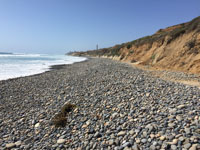
Figure 17-7. Gravel deposit on South Carlsbad Beach, CA

Fig. 17-8. Artificial islands in Dubai, United Arab Emirates |
17.6
Mineral Resources
Sea salts are generated from from
seawater evaporated in ponds. About 1/3 of all table salt (NaCl) in the world comes from evaporation seawater. Other economically significant mineral derivative from seawater evaporation operations include gypsum and salts of potassium, magnesium, iodine, and bromine.
Iron-manganese nodules are hydrogenous rocks that precipitated from seawater. They form very slowing (taking millions of years to form fist-size nodules, Figure 17-9). However, large regions of abyssal plains in the deep ocean are covered with them, particularly in the southern Pacific Ocean.. Samples collected show that they are rich in iron, manganese, copper, nickel, and cobalt. Mining manganese nodules from the deep sea bed is not considered economically feasible at this time. Similarly, deposits around deep sea vents (black smokers) are also rich in valuable metals but mining them is not economically feasible. However, ancient back smoker and manganese nodule deposits have been discovered and mined on land. |
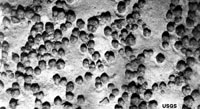
Fig. 17-9. Iron-manganese nodules on the seafloor on an abyssal plain in the South Pacific Ocean. |
17.7
Biological Resources
Seafood (fish, crustaceans, and mollusks) is perhaps the most valuable biological resource.
An estimated 86.6 million tons/yr., or 170,000 million pounds, of seafood are harvested around the world each year. Most seafood is harvested from temperate latitudes.
Seafood consumption has been gradually increasing worldwide, meanwhile fish and other seafood supplies have been diminishing, largely due to overfishing in poor, developing regions of the world. China alone consumes about 1/3 of all seafood harvested each year.
Aquaculture is gradually replacing traditional "capture" deep sea fishing. In the early 1970s only about 1 percent of seafood came from fish farms (aquaculture). Today, many kinds of seafood are farm raised - most abundant are freshwater-trout, catfish, and crayfish, but marine aquaculture is increasing, primarily salmon, oysters, mussels, shrimp, crabs, lobster, and other crustaceans. Aquaculture now account for more than 80% of the seafood in China, and nearly about 30% consumed by the rest of the world (Figure 17-10). Most varieties of commercial fish are now farm raised or captured in a managed and (hopefully) sustainable manner (Figure 17-11). Capture fishing has become increasingly infeasible in many parts of the world where many ocean fish stocks have been depleted. Traditional hook-and-net style fishing has many environmental problems. Drag nets scour the seafloor, destroying benthic communities, and large nets capture and kill unintended sea creatures including sea turtles, marine mammals, and many other endangered species. Lost nets, fishing lines, and trash from fishing ships are a major source of trash in marine pollution. Many advances are being made in marine aquaculture, however, it too can have environmental consequences including generating large quantities of fish wastes, interfering with native species populations (including spreading diseases), and taking space away from natural benthic communities.
Commercial whaling in the 19th and 20th centuries had a devastating impact on many marine mammal species. Whales were harvested for meat, oil, and for fertilizer. Whaling operations peaked in the 1950-60's with approximately 60,000 whales a year. As a result, whale populations crashed. 8 out of 11 species are now considered "commercially extinct." Whale population estimates are that 4.4 million commercial whales were in the world resource population in 1900, but only about 1 million are estimated to exist today. Large-scale commercial whaling operations ceased in 1987 worldwide with exception of small operations still being conducted by Japan, Norway, and some coastal North American tribes.
Marine plants are being farm raised for food and other purposes. For example, extracts from kelp is used as a clarifier in beer and to form emulsions in salad dressings, inks and paints.
|

Fig. 17-10. Aquaculture (fish and shellfish farms) account for about 20 percent of the seafood sold in the United States.

Fig. 17-11. Most sushi prepared in the United States are from farm-raise species. |
17.8
Coastal Land Resources
Coastal lands are probably the most rapidly changing and
economically significant part of the Earth's physical environment. According to United Nations reporting, presently about 40 percent of the world's population lives within 60 miles (100 kilometers) from a coast. The population density and development within the first mile of a coastline is typically both the most densely populated and also the highest value in terms of real estate value (Figure 17-12). However, this desire from humans to live along coastlines also comes at a great price to long-term sustainability of natural resources associated with coastlines. In many regions, features such as mangrove forests and wetlands are disappearing as development progresses. The predicted problems associated with sea-level and climate change rise will progressively cause catastrophic impacts. In 2017, the United Nations released a report that natural disasters are the greatest threat to humanity, and most of those disasters are associated with superstorms impacting coastal regions. |
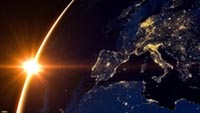
Fig. 17-12. A night sky view of Europe showing city lights highlights the fact that the world's coastlines are among the most densely populated regions of the planet. |
17.9
Marine Pollution
Major types of ocean pollution include:
* Petroleum
* Sewage
* Solid Waste
* Heavy metals and toxic chemical compounds.
Critical factors relating to ocean pollution:
*There are many ways these substance end up in the ocean ranging from intentional dumping, acts of ignorance, to impacts of disasters (natural and otherwise).
* The majority of pollutants come from land. According to NOAA studies, about 80 percent of marine pollution comes from sources on land (Figure 17-13).
* Man-made products become pollution when exposed to natural processes that move them through the natural environment. Materials like paper and metals typically decay, but plastic and glass can survive indefinitely. Plastic bags, nets, and fishing lines can trap, injure, and strangle marine creatures. Small plastic objects are consumed and block digestion. Inks, dyes, metals, and toxins from cigarette butts can poison sea life on all tropic levels.
|
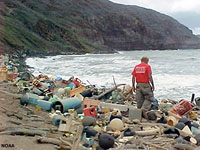
Fig. 17-13. Garbage that has washed up on a beach in Hawaii. |
17.10
Pollution and Pollutants
Pollutants comes in many forms and from many sources. The impact of pollutants depends on many factors: chemical properties, concentrations, what they react with, what they can convert into, and where and how they may become concentrated through both physical or biological processes. Some chemicals are purely toxic, poisoning organisms in small concentrations, loss of biomass, interfering with reproduction, growth, neurological and respiration function, and causing organ failure, and death. Some chemical pollutants make it more difficult for water to hold gases (such as O2 and CO2). Solids in silt or clay form can cover benthic animal, clog filter feeders, and block sunlight.
Some chemicals bio-amplify. Biologic amplification involves a toxin that does not metabolize and accumulates in an organism, and possibly increases in concentrations as it moves up the food chain. For example the banned insecticide DDT goes through biologic amplification as it is consumed in a contaminated ecosystem. DDT is an example of a chemical pollutant that goes through biologic amplification as it moves up the food chain (Figure 17-14).
|
Tropic Level in Food Chain |
DDT concentration
in parts per million |
| Phytoplankton |
0.000003 ppm. |
| Zooplankton |
0.04 ppm |
| Small fish |
0.5 ppm |
| Large fish |
2.0 ppm |
| Birds |
25 ppm |
|
| Fig. 17-14. Biologic amplification is illustrated by DDT. Through political action it was finally banned in 1972 by the United States Environmental Protection Agency. DDT is discussed more below. |
17.11
Point and Non-Point Sources of Pollution
All pollution has a source of origin. Point sources are visibly obvious sources. The U.S. Environmental Protection Agency (EPA) defines point source pollution as “any single identifiable source of pollution from which pollutants are discharged, such as a sewage outfall, a ship, or a smokestack.” Strict laws and regulations implemented in recent decades have helped reduce pollution from point sources in most developed countries (mostly because they are visibly obvious and can be linked directly to an original fiscally-responsible source). However, the major contributions to marine pollution come from non-point sources associated with runoff from land (Figures 17-15 and 17-16). Some ocean pollution starts as air pollution. Non-point sources include small sources (cars, trucks, boats, septic tanks, chimney smoke), and larger sources including agricultural wastes (pesticides, herbicides, fertilizer, and animal wastes) from farms, ranches, and harvesting forest areas. Runoff from industrial and urban areas (roads, parking lots, roofs), faulty managed industrial operations, and poorly-designed waste-water treatment facilities contribute pollutants and garbage to marine settings.
Pollution, and the secondary effects of pollution (causing harmful bacterial and algal blooms), can be very harmful to both wildlife and humans. About a third of shell-fish growing coastal waters are adversely impacted by pollution. Coastal waters and beaches are often unsafe for swimming after storm runoff. |

Fig. 17-15. Non-point source pollution illustrated in Florida.

Fig. 17-16. Sources of non-point pollution affection coastal waters. |
17.12
Environmental Concerns with Petroleum Industry Activities
As discussed in previous chapters, most scientists point to fossil fuel consumption as a primary cause for global warming and associated climate change—a topic of greatest concern for the future fate of humanity and the quality and biodiversity of the world's physical environments.
More discussion related to petroleum pollution is discussed below under Marine Pollution. The burning of fossil fuels (oil, gas, coal) are a primary factor impacting climate change. Although alternative energy sources are gradually reducing the demand for fossil fuels in the United States, the consumption worldwide is still gradually increasing (Figure 17-17).
Petroleum exploration, production, and consumption are the leading causes of pollution affecting the oceans. Petroleum includes crude oil, refined oil products, oil, gas, and tars (asphalt), petroleum derivatives (plastics, waxes, etc.), and greenhouse gases and toxins released by the production and burning of fossil fuels.
Sources of Carbon Dioxide (CO2) Emissions
Carbon dioxide entering Earth’s atmosphere comes from the oceans, soil, plants, animals and volcanoes. Greenhouse gases and pollution from the consumption of fossil fuels is now considered a major cause of climate change and changes in ocean chemistry detrimental to sea life. Climate change investigations show that although human sources of carbon dioxide are much smaller than natural emissions. However, human-source CO2 emission have been significantly increasing since the Industrial Revolution began in the 19th Century. Human activities are offsetting the balance between “sources” of emissions and “sinks” that remove CO2 from the atmosphere. Currently carbon dioxide emissions from fuel combustion include about 43% from coal, 36% is produced by oil, and 20% from natural gas. Destruction of natural “sinks” on land are cause by deforestation and degradation of organic-rich soils in developing agricultural regions which are also releasing large quantities of CO2 into the atmosphere.
Crude oil is a natural resource. Petroleum (gas, oil, and tar) form naturally in the Earth’s crust and are derived from sedimentary deposits, mostly from the continental margin regions of the world (both ancient and modern settings. Crude oil and gas forms from the slow biological and thermal decay of organic remains and residues buried in sediments. It typically takes many millions of years for organic-rich sediments deposited in coastal swamp regions, continental shelves, or the deep ocean to go through the processes to be converted to petroleum resources. The conversion involves: how much organic matter occurs in sediments, how much heat the sediments are exposed to, and for how long it is exposed. The more time organic matter is exposed to heat, the more it breaks down to by-products of gases, fluids (oil), and heavy carbon-rich residues (tar), (Figure 17-18). Most of these materials remained trapped in sediments, but gas and oil can migrate to underground reservoirs or escape to the surface.
Unrefined crude oil is generally biodegradable. Many microscopic organisms (chiefly bacteria) will consume crude oil, however, refine oil products are generally non-biodegradable and are more toxic to wildlife. Light, volatile components will gradually evaporate. Heavier, carbon-rich residues can take much longer. Crude oil breaks down faster with higher temperatures, so spills in cold-water settings take much longer to break down.
Tar balls are a common feature found on beaches around the world. It must be noted that roughly half of the tar balls found on beaches come from natural sources (oil seeps on the seafloor). The other half comes from human activity (pollution). Natural tar seeps are typically common in oil production regions. For instance, anyone visiting the beaches in and around Santa Barbara, California will note that their shoes will become covered with tar after walk on the beach. Although there is oil drilling and production operations both offshore and onshore in the region, the tar on the local beaches mostly comes from natural sources: seeps on the seafloor. |
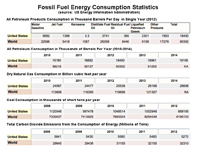
Fig. 17-17. Statistic of fossil fuel consumption and CO2 emissions for the US and World.
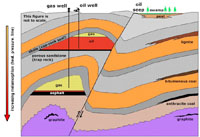
Fig. 17-18. Organic maturation converts organic matter into coal, oil, and gas with burial over time.
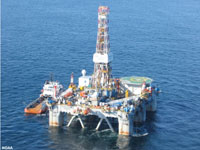
Fig. 17-19. Deepwater Horizon submersible drilling platform before the disaster in 2010.
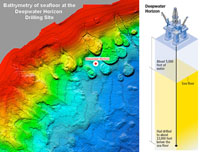
Fig. 17-20. Location of the Deepwater Horizon disaster. |
17.13
Impact of Large Petroleum-Related Disasters
Large marine disasters involving petroleum spills have happened many times over the past century. The impact of these events depends on where and how they occur. Some are accidents, others include intentional acts of war, such as the destruction of Kuwait’s oil fields in the First Gulf War. Oil spills can have a wide variety of impacts ranging from minimal (when far from coastal regions) to catastrophic when they impact shore regions. Two of the largest (most expensive) petroleum-related disasters affecting North American coastal waters are discussed below. |
 Fig. 17-21. The Deepwater Horizon on fire in 2010. Fig. 17-21. The Deepwater Horizon on fire in 2010. |
17.14
The Deepwater Horizon Disaster, 2010
The Deepwater Horizon Disaster started on April 20, 2010 with an explosion and fire of a submersible drilling platform located in the Gulf of Mexico about 40 miles (64 km) offshore from the Louisiana coast (Figures 17-19 to 17-27). The drilling operation involved tapping an oil reservoir deep in sedimentary deposits on the offshore region beyond the continental shelf. Problems with the drilling operation and failure of equipment to prevent a blowout that resulted in the explosion and fire, and the eventual sinking of the drilling platform two days later. 17 platform workers were killed and another 11 were injured by the explosion and fire. The open well, sheared of at the seabed, proceeded to spew large quantities of crude oil into Gulf waters until it was shut down in mid July when a 75 ton cap was put in place, sealing off the well. The disaster resulted in the largest oil spill in the history of the Petroleum Industry.
An estimated 200 million gallons (about 5 million barrels) of oil poured into ocean from the unconstrained well. Some of oil stayed on or near the seabed, much of it formed a large plum in layers within the ocean waters, and some migrated to the surface where wind and currents dispersed it. An extensive cleanup effort was undertaken to trap, degrade and disperse, or burn off much of the oil on the surface. Unfortunately, large amounts found its way onshore, impacting beaches and coastal wetlands, and severely impacting wildlife. The bad publicity wreaked economic havoc on coastal communities and businesses involved in fishing and recreation from Texas to Florida. As of 2015, BP (the company that operated the drilling program) agreed to pay $18.7 billion to settle all federal and state claims for the disaster - the biggest pollution penalty in U.S. history. Total settlement costs was in the range of $54 billion.
Settlement of all federal and state claims brings total costs to nearly $54 billion. BP PLC agreed to pay $18.7 billion to settle all federal and state claims arising from the 2010 Deepwater Horizon oil spill, including the biggest pollution penalty in U.S. history.
Because the spill happened in the warm open ocean waters, much of the crude oil from the spill eventually dispersed (evaporated or diluted) or was consumed by microbial activity.
 |
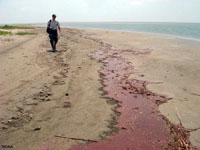 |
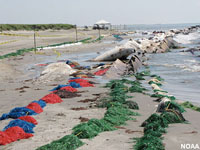 |
| Fig. 17-25. An oil-soaked bathtub ring in wetlands. |
Fig. 17-26. Oil on a beach along the Gulf of Mexico. |
Fig. 17-27. Pompoms and booms used to trap oil. |
|
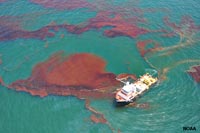
Fig. 17-22. An oil slick spreads on the Gulf of Mexico from the Deep Horizon disaster.
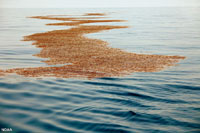
Fig. 17-23. Oil-soaked sargassum (seaweed) in the Gulf of Mexico.
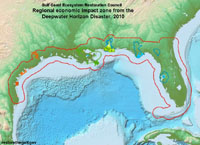
Fig. 17-24. Regional economic impact zone map of the Deepwater Horizon Disaster of 2010. The disaster impacted fishing, tourism, recreation, and the livelihoods of millions of Gulf Coast residents. |
17.15
Exxon Valdez Oil Spill Disaster, 1989
Prior to the Deepwater Horizon disaster, the worst petroleum-related disaster affecting the US coastline was the Exxon Valdez oil spill (Figures 17-28 and 17-29). The oil spill occurred in Prince William Sound in the Gulf of Alaska. The Exxon Valdez, a large oil tanker bound for refineries in Long Beach, California, veered off course and struck a submerged rock “reef” outcrop on March 24, 1989. The disaster was blamed on poor navigation by a drunken ship captain, poorly trained personnel, and faulty and unused navigation equipment.
Estimates by governmental and other sources suggest that at least 10 to 11 million gallons (about 250,000 barrels) of Alaskan crude oil spilled into the coastal waters. The spill, so close to shore, eventually impaction about 1,300 miles (2,000 km) of coastline in the Gulf of Alaska (closer to 9,000 miles [14,500 km] considering all the islands, headlands, and bays along the rugged coastline). Rough seas, and the rugged and remote coastline made clean-up efforts extremely difficult, and the cold-water setting hampered the rapid decay and dispersion of the oil. The spill devastated habitats for salmon, seals, seabirds, and sea otters, and had a catastrophic effect of coastal communities in the region. The cost of the disaster, spread over many years, was in the range of about $7 billion. Hard facts were learned from the disaster. It turns out that some of the beach areas were "cleaned" - basically cooked with 150 F water. These areas were actually harmed more by the cleaning processes used. It was determined that about 35% of the oil evaporated, 8% burned, 5% dispersed by surf , and only about 5% biodegraded; the rest formed slicks that dispersed into the greater ocean currents offshore.
An outcome of the disaster is that all new large petroleum-transport vessels are now being built with double hulls to hopefully prevent future transport-spill disasters.
|
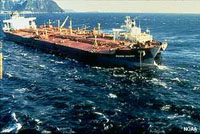
Fig. 17-28. The Exxon Valdez leaking crude oil into the Gulf of Alaska in 1989.
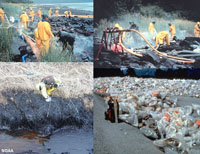
Fig. 17-29. Clean-up effort on Alaskan beaches after the Exxon Valdez oil spill disaster. |
17.16
Impact of Petroleum Pollution on Wildlife
Pollution from petroleum-source products is a major problem in parts of the worlds oceans and coastlines. In addition, tar-ball, waxes, and other petroleum-derivative products can now be found throughout the world’s oceans. Evidence of the pollution is most abundant along developed (urban and industrial) coastlines where accidental spills occur most frequently. The risks of spills occur along all infrastructure systems associated with the petroleum production, refining, transportation, and consumption. Leaky oil from cars and trucks are a major non-point source of water pollution. Large oil spills and oil production disasters are some of the most costly, devastating both wildlife and the economic livelihoods of communities in regions where they occur (Figure 17-30).
Oil spills are particularly bad for homeothermic (warm blooded) organisms with fur of feathers. Saturation with oil causes these animals to loose insulation and they die from hypothermia. Oil slicks poison kill 150-450,000 sea birds killed each year. Organisms living in the intertidal zone most sensitive to oil contamination.
Refined oil and oil-derivative products tend to be non-biodegradable, and are more toxic to wildlife. |
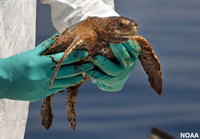
Fig. 17-30. A turtle being rescued from an oil slick in the Gulf of Mexico after the Deepwater Horizon Disaster. Sea creatures that are rescue are cleaned with soap and released in oil-free waters. |
17.17
Solid Wastes
Marine debris is a persistent pollution problem of global problem. Marine debris is a threat to wildlife, navigation safety, and is a factor affecting the economy and human health, particularly in poor countries in coastal regions. According to NOAA sources, approximately 1.4 billion pounds of trash per year ends up in the world’s oceans. The major components involve floating consumer plastic objects (including plastic bottles and caps, cigarette butts and lighters, and plastic bags), and these materials decay very slowly, if at all. Other materials include metals, rubber, paper, textiles, construction materials, and glass. The entire world’s oceans are impacted by solid wastes transported by currents. Large portions of the ocean in the center of the large gyres have become floating garbage patches where floating debris is accumulating.
Trash comes from many sources, mostly by careless acts that release trash into storm drains and eventually drain into coastal waterways. Some trash material blown into the by the wind. Much of it comes from coastal recreation and shoreline activities. In impoverished regions, garbage is intentionally dumped at sea. Fishing nets, hooks, lines, abandoned vessels are lost, drifting at sea. Trash washes up on beaches, accumulates on the seafloor, or drifts practically endlessly as sea. Trash is very harmful to wildlife. Small objects that are swallowed cannot be digested, often injuring or killing sea life. Bags, lines, and nets entangle animals, leading to starvation or strangulation.
Garbage patches are regions in the world's oceans where downwelling waters in the middle of ocean gyre region cause floating garbage to accumulate (discussed in Ocean Circulation, Chapter 9).
Video: 11 Things Found After Japanese Tsunami
|
17.18
Sewage
In many regions of the world sewage from populated regions is a major source of pollution in coastal regions. Sewage is a major problem in poor and overpopulated communities that cannot afford the technology to treat and process sewage before it is released into rivers or coastal waters. Old, over-used, and poorly-designed waste treatment facilities often cannot handle the volume of both sewage and runoff created by storms. As a result raw sewage can find its way into coastal waters (Figure 17-31).
Sewage from urban areas include human wastes, food wastes, and household and industrial chemical wastes of many kinds from any different sources.
|
 |
| Fig. 17-32. Sewage discharged from a point source on the Calumet River, Illinois. |
In San Diego County, urban runoff through storm drains account most of the coastal pollution resulting in beach closures.
The rule of thumb is that for every rain greater that ¼ inch, it is advised to stay out of the ocean for 72 hours.
Here’s the variety of diseases you can get from swimming in contaminated water:
- Sinus infection
- Hepatitis A (bad)
- Gastrointestinal problems, including Cholera
- Staff infection
- Blood poisoning.
|
17.19
Heavy Metals and Toxic Compounds
Heavy metals and other toxic contaminants can accumulate in seafood and make it harmful to eat. According to NOAA sources, more than a third of the shellfish-growing waters of the United States are adversely affected by coastal pollution.
Mercury, lead, chromium, copper, cadmium, and arsenic are perhaps most significant. Mercury and lead are released into the environment from burning coal and fossil fuels, and by mining operations. Consumer products that contain lead, mercury, and other toxic metals end up in landfills which can leak into waterways. Lead from improperly disposed of batteries is a major contributor to lead contamination. Starting in the 1920‘s lead was used as an “additive” to gasoline to increase engine performance, but was found to be a toxic addition to air and soil pollution. It has been banned in most countries, but the lead is still finding its way into ocean waters. Lead and many other toxic compounds were also used in paints before being banned.
Mercury was used in gold mining and extraction, and in light bulbs, and used in many other industrial purposes, now mostly banned. Large quantities of mercury was mined in the New Almaden mercury mining district near San Jose, California. Over 65 million pound of mercury were extracted from the mines in the, nearly all of it was consumed in the gold fields along the western Sierra Mountains of central California and is a major contaminant in the Sacramento River system feeding into San Francisco Bay. Mercury is problematic in that it is concentrated in organisms highest in the food chain. In many areas, fish, such as tuna, have unsafe levels of mercury that, if over-consumed, can lead to mercury poisoning in humans. After WWII, a chemical process used to manufacture plastics released large quantities of mercury compounds into Minamoto Bay, Japan. The bio-accumulated mercury in fish that was the primary source of protein in the fishing community populations around the bay, nearly the entire population was sickened, many displaying severe neurological disorders.
Cadmium is used in non-rechargeable nickel-cadmium batteries, and is a major toxin in landfill waste waters. Both cadmium and arsenic are released by runoff from poorly managed mining operations, both past and present throughout the world today. Arsenic in a common natural contaminant in groundwater in some coastal regions. Various cancers and other diseases are linked to consuming contaminated water and food with high levels of arsenic.
Heavy metal pollutant come from many sources including mining, smelting, abandoned lead batteries and garbage, chromium from tanneries, and other local industrial sources mostly in impoverished urbanized areas where there is little or no regulation oversight. Modern electronic gadgets are host to many toxic metals and organometallic compounds and should be recycled (not thrown into landfills that may leak toxins). Research by world health organizations report that at least 100 million people worldwide suffer health effects or die from heavy-metal pollution each year.
|
17.20
Phosphorus, Nitrogen, and Other Nutrient Pollution
The nutrients in fertilizer makes plants grow. Whereas using fertilizers may help crop yields (and profits) on land, their unintended release into waterway that lead to the ocean can have devastating impacts in the marine environment. Phosphorus and nitrogen compounds are essential nutrients for plant growth and is naturally occurring in upwelling ocean waters that support primary production. However, too much nitrogen and phosphorus from fertilizers used in agriculture and suburban lawn care can stimulate an overgrowth of phytoplankton resulting in a harmful algal bloom (HAB). When the phytoplankton sinks, dies, and decays, it can suck all the free oxygen out of the water, resulting in hypoxia (creating “dead zones” in regions that would otherwise be a marine environment teaming with life). Unwanted nutrients in runoff and groundwater seepage from agricultural and urban areas of the Midcontinent region of the United States is resulting in an ever-expanding dead zone in the coastal waters around the mouth of the Mississippi River in the Gulf of Mexico (Figure 17-33).
|

Fig. 17-33. Map of the region near the mouth of the Mississippi River impacted by hypoxia caused by harmful algal blooms caused by nutrient pollution from farms and urban areas inland. |
17.21
Synthetic Organic Chemicals
Many types of organic compounds produced by humans have a toxic effect on the environment. Many synthetic organic chemicals
are manufactured or are a byproduct in the production of many industrial, agricultural, and household products. Large quantities of synthetic materials were produced and released into the environment in the period after WWII until environmental regulation and control began to prevail in the 1970s. In that time interval, a great amount of damage was done in many industrialized coastal regions.
Among the
worst are chlorinated and halogenated hydrocarbons: DDT, TCE, and PCB’s (There are many others!).
* DDT (dichlorodiphenyltrichloroethane) was heavily used as an insecticide throughout the United States, particularly starting after World War II. DDT is an insecticide that was initially used by the military in WW II to control malaria, typhus, body lice, and bubonic plague. After the war, this inexpensive-to-produce chemical was extensively used with agriculture for insect control (insecticide). In the 1960’s DDT was found to cause adverse affects to wildlife, most notably causing predatory birds to produce thin shells, too thin for offspring to survive. DDT was banned from agricultural uses in 1972 over concerns of the unmitigated toxic effects on human health and many organisms in the natural environment. Unfortunately, DDT and other similar pesticides are still used in poor countries around the world to fight mosquitoes carrying malaria and other diseases.
* PCBs (polychlorinated biphenyls) are industrial products or chemicals, commonly used as insulator fluids in old transformers. PCB contamination is common in old industrial regions, particularly in the eastern United States. PCBs were banned in the U.S. in 1979 because of concerns about unintended impacts on human and environmental health. Like DDT, PBCs bio-accumulate.
* TCE (trichoroethlene) as originally introduced as a general anesthetic until it was linked to severe neurological disorders. After WWII it is was widely used as an industrial solvent, used primarily to degrease engine parts. TCE poisoning began to increase in many areas where the liquid chemical was dumped into sewers and wells, contaminating water supplies for many communities. It was later determined to be carcinogenic was banned in the 1980’s by most developed nations.
PFAS (Per- and polyfluorinated alkyl substances): PFAS, of which there are more than 4,700 known varieties are collectively known as "Forever Chemicals." PFAS are resistant to water, grease, and heat, and are found in a range of everyday products including food packaging, cosmetics, clothing, and even toilet paper. PFAS are because both potentially toxic and and are resistant to breaking down, as a result they accumulating in the environment, perhaps permanently.
The Environmental Protection Agency and other environmental watchdog organizations have the mission to inform, regulate, and control hazardous chemical migration, from sources at manufacturing, to where they finally end up in the environment. The best practice would be to eliminate their "sources" - but this is an almost impossible task, especially when profits impact politics.
|
17.22
Medical Wastes
Biologists are also reporting negative impacts of pharmaceutical compounds, medical wastes, and byproduct, including birth control pills, anti-depressants, and chemotherapy drugs finding their way into coastal waters. Illegal dumping of medical wastes at sea has been a large problem. Many coastal cities have had to deal with illegal dumping of medical wastes (commonly used hypodermic needles). Beaches were closed in many areas in the New York City region during the 1990s because of dangerous quantities of contaminated needles washing up on shore. |
17.23
Coastal Dredging
Dredging of sediments filling in submarine shipping channels and harbors re-releases environmental toxins that have already accumulated in nearshore marine sediments. Dredging also releases fine sediments rich in organic matter that contribute to anoxia and other detrimental benthic environmental impacts in the vicinity (Figure 17-34). The material that settles in harbors, shipping channels, and inland waterways are in constant motion during dredging operations, and wildlife habitats that might be able to tolerate a few days of high turbidity are endangered by the unending release of fine-grained sediments released by a long-term dredging operation.
|

Fig. 17-34. A dredging operation like this one works to remove silt from clogged shipping channels. |
17.24
Protecting the Marine Environment
Many national, state, and local governments and organizations have been struggling for decades to manage marine pollution and protect coastal environments. In the United States, the National Oceanographic and Atmospheric Administration (NOAA) overseas large portions of the coastal waters around North America, attempting to stop overfishing and restricting coastal development in many regions. Expanding efforts involve protecting coastal wetlands, mitigating coastal hazards, ensuring public coastal access, protecting beaches and coastal park lands, locating of energy and government facilities, and managing sensitive habitats, fishery areas, and aquaculture. Efforts are underway nationwide to prevent and control polluted runoff by replacing outdated storm water runoff and sewage systems, reducing agricultural pollutants, preventing or mitigating development within sensitive habitats and erosion-prone areas, and finding ways for communities to reduce refuse and debris from entering coastal waters.
|
17.25
Focus on Coral Reefs
Coral reefs (or coral ecosystems) are among the most important and also most sensitive habitats throughout the world’s oceans. Reefs provide habitat, spawning and nursery grounds for economically important fish species, and are hotspots of marine biodiversity. For humanity, coral reefs provide billions of dollars in economic and environmental benefits, including fishing, coastal protection, recreation, and tourism. Hundreds of millions of people worldwide depend of reef ecosystems for their livelihoods and food. However, coral ecosystems face serious threats from unsustainable fishing and land-based pollution (Figures 17-35 and 17-36).
Unfortunately, many of the world’s reefs have already been destroyed or severely damaged by pollution, unsustainable fishing practices, disease, introduction of invasive species, ship groundings, uncontrolled coastal development and other impacts.
Human activities are a primary cause for reef destruction. Pollutants from expanding coastal communities find their way to shallow coastal waters dominated by coral reefs, mostly in warm tropical waters. Many of the sea creatures, particularly invertebrates that attach to the seabed and filter seawater. Tourist visiting reefs step on fragile reef structures, introduce chemicals (such as zinc and other compounds in sun screen). Sewage and urban runoff carries silt (increasing turbidity) and introduce toxins that impact or kill reef organisms. Perhaps most alarming are the impacts of changes in water temperature and water chemistry associated with climate change.
|

Fig. 17-35. A healthy Hawaiian coral reef.

Fig. 17-36. A dying coral reef. |
17.26
Climate Change - The most important environmental issue of our times!
Studies conducted throughout the world’s oceans show the coral ecosystems are showing the detrimental effects of climate change caused by the burning of fossil fuels, deforestation, and bad agricultural practices that release large quantities of greenhouse gases into the atmosphere.
Climate change impacts coral ecosystems by increasing sea-surface temperatures and increased carbon dioxide levels in seawater. Long-term studies of CO2 concentrations in seawater show trends in reducing calcification rates in reef-building and reef-associated organisms. Increased sea surface temperature leads to coral bleaching (a result in the loss of symbiotic algae and bacteria) and death of skeletal reef-building organism. Weakened coral communities are susceptible to infection disease. Pollution from coastal development and agricultural runoff can also impede coral growth and reproduction, disrupt ecological functions, and cause disease.
Coal is the most carbon-intensive fossil fuel, producing the most carbon dioxide per unit volume burned. For every ton of coal burned, approximately 2.5 tons of CO2 is released into the air. Globally, coal is the largest-used fossil fuel source and the highest production of carbon dioxide emissions. Although coal represents only about one-third of share of fossil fuels consumed by the world’s total primary energy supply, coal is responsible for 43% of carbon dioxide emissions from burning fossil fuels.
Politics of Climate Change: Sadly, our world may be in big trouble because of the economics associated with energy and agricultural demands of a growing world population. Failure to address carbon emissions and the resultant impacts of rising temperatures and ocean acidification could make many marine and coastal management efforts futile. While reducing CO2 and other greenhouse gas emissions is vital to stabilize the global climate is essential, the excess that already exists in the atmosphere will persist throughout the next century.
Climate changes will have many impacts on marine systems including reduction in marine biodiversity, sea level is rising, and long-term forecasts predict changes in the frequency, intensity, and distribution of tropical storms as atmospheric and ocean circulation patterns change. |
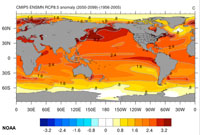
Fig. 17-37. A map produced by NOAA showing changes in the mean sea surface temperature for the latter half of the 21st century. Estimates vary, but long-range predictions show that the ocean warming is greatest in the Northern Hemisphere where changes are currently more than 3° Celsius (~5.5° F). Weaker warming is seen in the North Atlantic and the Southern Ocean. |
17.27
Politics vs. Technology: The key to saving or destroying our natural environments
The climate change issues will be every-increasingly important as the impacts become increasingly obvious as the number of natural and man-made disasters steadily rises. Humans have to collectively choose, through political means, to make the choices to change to cleaner technologies, and protecting and managing resources. The choices to move away from fossil-fuel consumption to alternative energy sources will be expensive and a hard fight because it will impact the livelihoods of many people (such as coal miners and workers in the petroleum industries). Predicted sea-level rise and global warming will impact all world's communities, both human and ecosystems. There will be many winners and losers in the transition to a cleaner, more sustainable world. Accepting the consequences for climate change will create many new jobs in the process. The longer humanity waits to make these changes, the greater the environmental problems will be in the future. "We can't fool mother nature!"
|
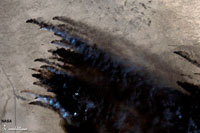
Fig. 17-38. Major fires burned for months with the bombing of Kuwait's oil fields in 1991, resulting in a major environmental calamity, both on land and offshore. |

Fig. 17-39. Satellite views of burning oil fields in Kuwait. |
|






































